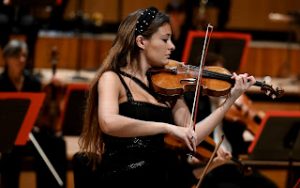
Photograph credit: Camilla Greenwell
Nicola Benedetti plays Brahms
South Bank Centre’s Royal Festival Hall
Philharmonia
Conductor: Cristian Macelaru
Sunday 01 October
The concert opener – One Line, Two Shapes by Nico Muhly – stems from Pandemic isolation and must be a very challenging piece to bring off from cold because it starts with the softest possible chorale played by two celli and two double basses. It then builds gradually before being interrupted with staccato string chords – played with commendable dramatic incisiveness. I rather enjoyed the bowed xylophone and the acoustic effect of placing a small group of lower strings behind the brass.
Then it was off to the familiar, beloved sound world of Brahms’s violin concerto – except that Nicola Benedetti, tall and elegant in her long black dress, made it seem completely fresh. Visibly and physically feeling her way into the music during the opening orchestral section, she attacked the first movement (Allegro non troppo) with warmth, energy and passion interspersed with a lot of sweetness and imaginative, dynamic colour in the cadenza. The adagio felt like a cool oasis after the heat of the allegro. The oboe solo (Timothy Rundle) was almost painfully beautiful and nicely supported by the rest of the woodwind section especially the bassoons. And from the solo violin entry there was a strong sense of conversation and rapport between Benedetti and the string section principals. Finally Macleru, clearly very much at home with Benedetti, made sure that the Allegro giocoso danced to the end of the concerto with joyful exuberance. Benedetti’s slender fingers, incidentally, are fascinating to watch as she trills effortlessly on all four fingers – surely the envy of every amateur string player in the hall?
After the interval came Rachmaninov’s third symphony with its many sections and mood changes across the unusual three movement structure. And the performance was full of things to admire – the legato string playing over the wind cross rhythms in the first movement and impeccable solo work from leader Zsolt-Tihamer Visontay for example. In a work which changes direction so often, it’s important to find plenty of tension and Macelaru certainly did that especially in the adagio in which he stressed the detail from, for instance, harps and celeste before reaching the busier central section with its sudden, trumpet fanfares. It’s a big work (five percussionists plus timps) and here it purred along joyfully with players appearing to enjoy it as much as the rapturous audience did.